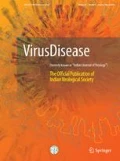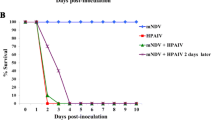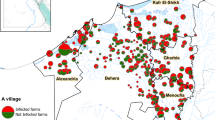Abstract
Highly pathogenic avian Influenza (HPAI) is an important zoonotic disease and is becoming a great threat to poultry industry. India has experienced continual outbreaks of H5N1 HPAI virus since February, 2006 especially in Eastern India. Survivability in poultry faeces is an important determinant in evaluating the persistence of the virus in the poultry sheds and their vicinity. In this paper, survivability of Indian H5N1 HPAI virus in dry and wet poultry faeces at 42, 37, 24 and 4 °C, respectively is reported. The effect of different temperatures was determined by linear regression model and defined in terms of linear equation. The virus survived up to 18 h at 42 °C, 24 h at 37 °C, 5 days at 24 °C and 8 weeks at 4 °C in dry and wet faeces, respectively. The coefficients of determination (R2) values for dry and wet faeces revealed that the difference in viral persistence in dry and wet faeces at all temperatures was not very marked. Results of the present study indicated that H5N1 HPAI virus may remain viable for extended periods of time in faeces at low temperatures and may act as a long term source of influenza virus in the environment.
Similar content being viewed by others
References
Alexander DJ. A review of avian influenza in different bird species. Vet Microbiol. 2000;74:3–13.
Beard CW, Brugh M, Johnson DC. Laboratory studies with Pennsylvania avian influenza viruses (H5N2). Proceedings of the US Animal Health Association, 4th Worth, TX, USA, 1984;88:462–473.
Benedictis DP, Beato MS.Capua I. Inactivation of avian influenza viruses by chemical agents and physical conditions: a review. Z Pub H. 2007;54:51–68.
Brown JD, Swayne DE, Cooper RJ, Burns RE, Stallknecht DE. Persistence of H5 and H7 avian influenza viruses in water. Avian Dis. 2007;51:285–9.
Centers for Disease Control and Prevention Key facts about avianinfluenza (bird flu) and avian influenza A (H5N1) virus. 2005. http://www.cdc.gov/flu/avian/gen-info/pdf/avian_facts.pdf. Accessed 5 May 2012.
Chumpolbanchorn K, Suemanotham N, Siripara N, Puyati B, Chaichoune K. The effect of temperature and UV light on infectivity of avian influenza virus (H5N1, Thai field strain) in chicken fecal manure. Southeast Asian J Trop Med Pub Health. 2006;37:102–5.
Dubey SC, Nagarajan S, Tosh C, Bhatia S, Krishna L. Avian Influenza: a long-known disease and its current theat. Ind J Anim Sci. 2009;72:113–40.
Forrest HL, Jeong-Ki K, Webster RG. Virus shedding and potential for interspecies waterborne transmission of highly pathogenic H5N1 influenza virus in sparrows and chickens. J Virol. 2010;84:3718–20.
Hinshaw V, Webster RG, Turner B. The perpetuation of orthomyxoviruses and paramyxoviruses in Canadian waterfowl. Can J Microbiol. 1980;26:622–9.
Hinshaw V, Webster R, Turner B. Waterborne transmission of influenza a viruses. Intervirol. 1979;11:66–9.
Lee MS, Chang PC, Shien JH, Cheng MC, Shieh HK. Identification and subtyping of avian influenza viruses by reverse transcription PCR. J Virol Methods. 2001;97:13–22.
Li KS, Guan Y, Wang J, Smith GJD, Xu KM, Duan L, Rahardjo AP, Puthavathana P, Buranathai C, Nguyen TD, Estoepangestie ATS, Chaisingh A, Auewarakul P, Long HT, Hanh NTH, Webby RJ, Poon LLM, Chen H, Shortridge KF, Yuen KY, Webster RG, Peiris JSM. Genesis of a highly pathogenic and potentially pandemic H5N1 influenza virus in eastern Asia. Nature. 2004;430:209–13.
Lu H, Castro AE, Pennick K, Liu J, Yang Q, Dunn P, Weinstock D, Henzler D. Survival of avian influenza virus H7N2 in SPF chickens and their environments. Avian Dis. 2003;47:1015–21.
Markwell DD, Shortridge KF. Possible waterborne transmission and maintenance of influenza viruses in domestic ducks. Appl Env Microbiol. 1982;43:110–6.
Muhammad K, Das P, Yaqoob T, Riaz A, Manzoor R. Effect of physicochemical factors on survival of avian influenza virus (H7N3 type). Int J Agric Biol. 2001;4:416–8.
Murugkar HV, Nagarajan S, Tosh C, Bhatia S, Venkatesh G, Jain R, Kumar S, Khandia R, Pandey M, Tripathi S, Kulkarni DD, Dubey SC. H5N1 virus outbreaks in poultry in India. Vet Rec. 2008;162:255.
Nagarajan S, Murugkar HV, Tosh C, Behera P, Jain R, Tripathi S, Khandia R, Gupta V, Kulkarni DD, Dubey SC. Avian influenza virus (H5N1) in chickens in India. Vet Rec. 2009;164:128.
Nagarajan S, Tosh C, Smith DK, Peiris JSM, Murugkar HV, Sridevi R, Kumar M, Katare M, Jain R, Syed Z, Behera P, Cheung CL, Khandia R, Tripathi S, Guan Yi, Dubey SC. Avian influenza (H5N1) virus of clade 2.3.2 in Domestic Poultry in India. PLoS One. 2012;7(2):e31844. doi:10.1371/journal.pone.0031844.
Nazir J, Haumacher R, Ike AC, Marschang RE. Persistence of avian influenza viruses in lake sediment, duck faeces, and duck meat. Appl Env Microbiol. 2011;77(14):4981–5.
Pattnaik B, Pateria AK, Khandia R, Tosh C, Nagarajan S, Gounalan S, Murugkar HV, Shankar BP, Shrivastava N, Behera P, Bhagat S, Peiris JSM, Pradhan HK. Phylogenetic analysis revealed genetic similarity of the H5N1 avian influenza viruses isolated from HPAI outbreaks in chickens in Maharashtra India with those isolated from swan in Italy and Iran in 2006. Curr Sci. 2006;91:77–81.
Reed LJ, Muench H. A simple method for estimating the 50 % end points. Am J Hyg. 1938;27:493.
Slemons RD, Johnson DC, Osborn JS, Hayes F. Type A influenza viruses isolated from wild free flying ducks in California. Avian Dis. 1974;18:119–24.
Songserm T, Jam-on R, Sae-Heng N, Meemak N. Survival and stability of HPAI H5N1 in different environments and susceptibility to disinfectants. In: Schudel A, Lombarrd M, editors. Development of biological, vol. 24. Switzerland: Karger; 2006. p. 254.
Stallknecht DE, Shane SM, Kearney MT, Zwank PJ. Persistence of avian influenza viruses in water. Avian Dis. 1990;34:406–11.
Swayne DE, Jackwood MP. Pathobiology of avian influenza virus infections in birds and mammals avian influenza. In: Swayne DE, editor. Avian Influenza. Ames: Blackwell; 2008. p. 87–103.
Tosh C, Murugkar HV, Nagarajan S, Bhatia S, Pateriya AK, Behera P, Jain R, Kumar S, Khandia R, Vanamayya PR, Dubey SC, Ahlawat SPS. Outbreak of avian influenza virus H5N1 in India. Vet Rec. 2007;161:279.
Webster RG, Bean WJ, Gorman OT, Chambers TM, Kawaoka Y. Evolution and ecology of influenza A viruses. Microbiol Rev. 1992;56:152–79.
WHO, The Writing Committee of the World Health Organization. Consultation on Human Influenza A/H5. Avian influenza A (H5N1) infection in humans. New Eng J Med. 2005;353:1374–85.
York JL. Enzymes: classification, kinetics, and control. In: Devlin TM, editor. Textbook of biochemistry with clinical correlations. 4th ed. New York: Wiley-Liss; 1997. p. 127–78.
Acknowledgments
The authors are thankful to Indian Council of Agricultural Research and Director, Indian Veterinary Research Institute, Izatnagar, Bareilly for supporting this study and providing financial help to carry out this study.
Author information
Authors and Affiliations
Corresponding author
Rights and permissions
About this article
Cite this article
Kurmi, B., Murugkar, H.V., Nagarajan, S. et al. Survivability of Highly Pathogenic Avian Influenza H5N1 Virus in Poultry Faeces at Different Temperatures. Indian J. Virol. 24, 272–277 (2013). https://doi.org/10.1007/s13337-013-0135-2
Received:
Accepted:
Published:
Issue Date:
DOI: https://doi.org/10.1007/s13337-013-0135-2




